1.1 The Dual Characteristics of God
무형으로 계시는 하나님의 신성(神性)을 우리는 어떻게 알 수 있을 것인가? 그것은 피조세계(被造世界)를 관찰함으로써 알 수 있다. 그러므로 바울은 창세로부터 그의 보이지 아니하는 것들 곧 그의 영원하신 능력과 신성이 그 만드신 만물에 분명히 보여 알게 되나니 그러므로 저희가 핑계치 못할지니라(롬 1 : 20)고 기록하였다. 마치 모든 작품은 그 작자의 보이지 않는 성품의 실체적인 전개인 것같이, 피조세계의 삼라만상(森羅萬象)은 그것을 창조하신 하나님이 그의 보이지 않는 신성을 그의 실체대상으로 전개해 놓으신 것이다. 그러므로 작품을 보아 그 작자의 성품을 알 수 있는 것같이, 이 피조만물(被造萬物)을 보아서 하나님의 신성을 알 수 있는 것이다.
How can we know the divine nature of the invisible God? One way to fathom His deity is by observing the universe which He created. Thus, St. Paul said: Ever since the creation of the world his invisible nature, namely, his eternal power and deity, has been clearly perceived in the things that have been made. So they are without excuse (Rom. 1:20). Just as a work of art displays the invisible nature of its maker in a concrete form, everything in the created universe is a substantial manifestation of some quality of the Creator’s invisible, divine nature. As such, each stands in a relationship to God. Just as we can come to know the character of an artist through his works, so we can understand the nature of God by observing the diverse things of creation.
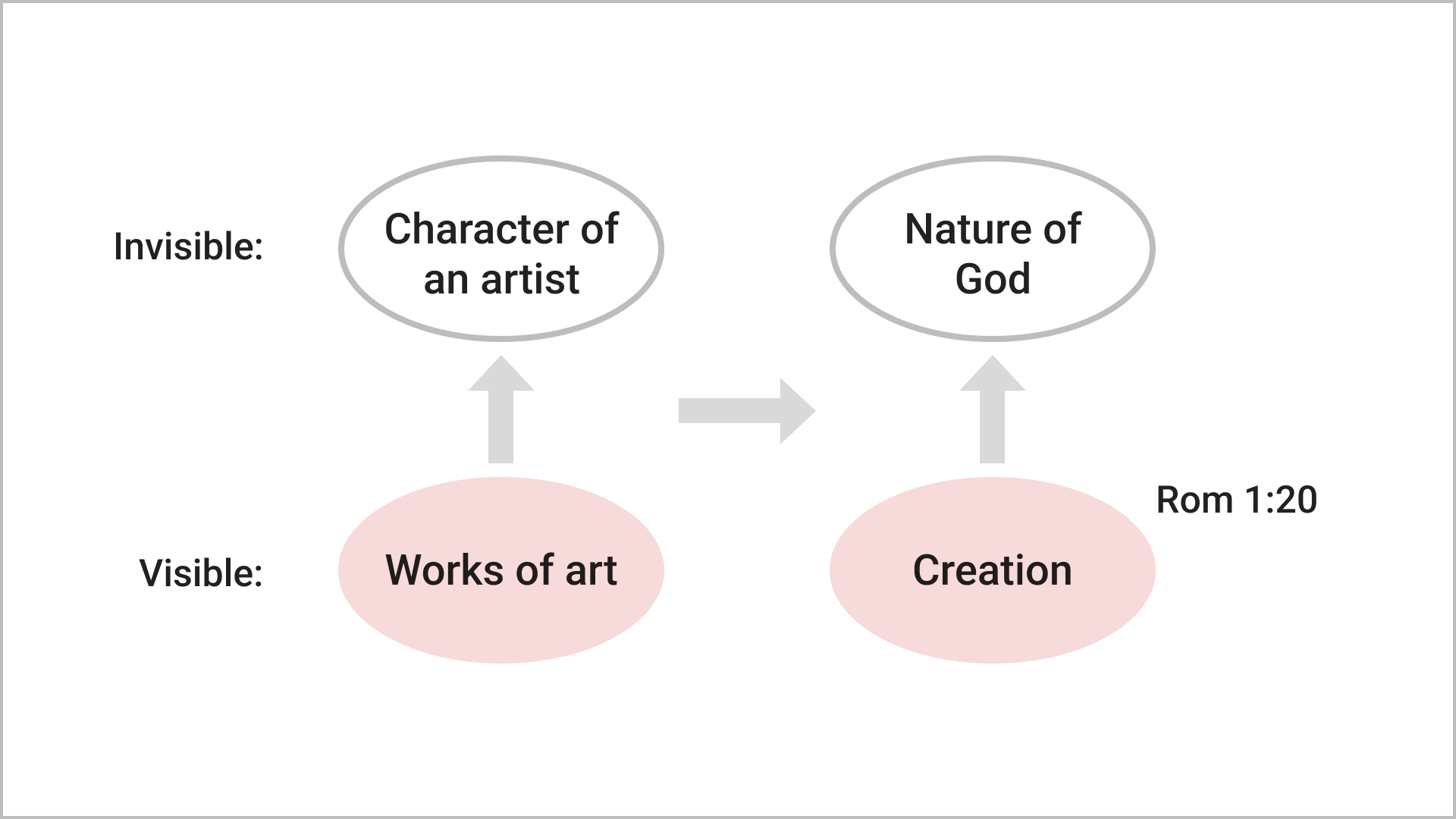
이제 우리는 하나님의 신성(神性)을 알기 위하여, 피조세계(被造世界)에 보편적으로 간직되어 있는 공통사실을 찾아보기로 하자.
Let us begin by pointing out the common elements which are found universally throughout the natural world.
존재하는 것은 무엇이든지 그 자체 내에서뿐만 아니라, 다른 존재들과의 사이에서 양성(陽性)과 음성(陰性)의 이성성상(二性性相)이 상대적 관계를 맺음으로써 비로소 존재하게 된다.
Every entity possesses dual characteristics of yang (masculinity) and yin (femininity) and comes into existence only when these characteristics have formed reciprocal relationships, both within the entity and between it and other entities.
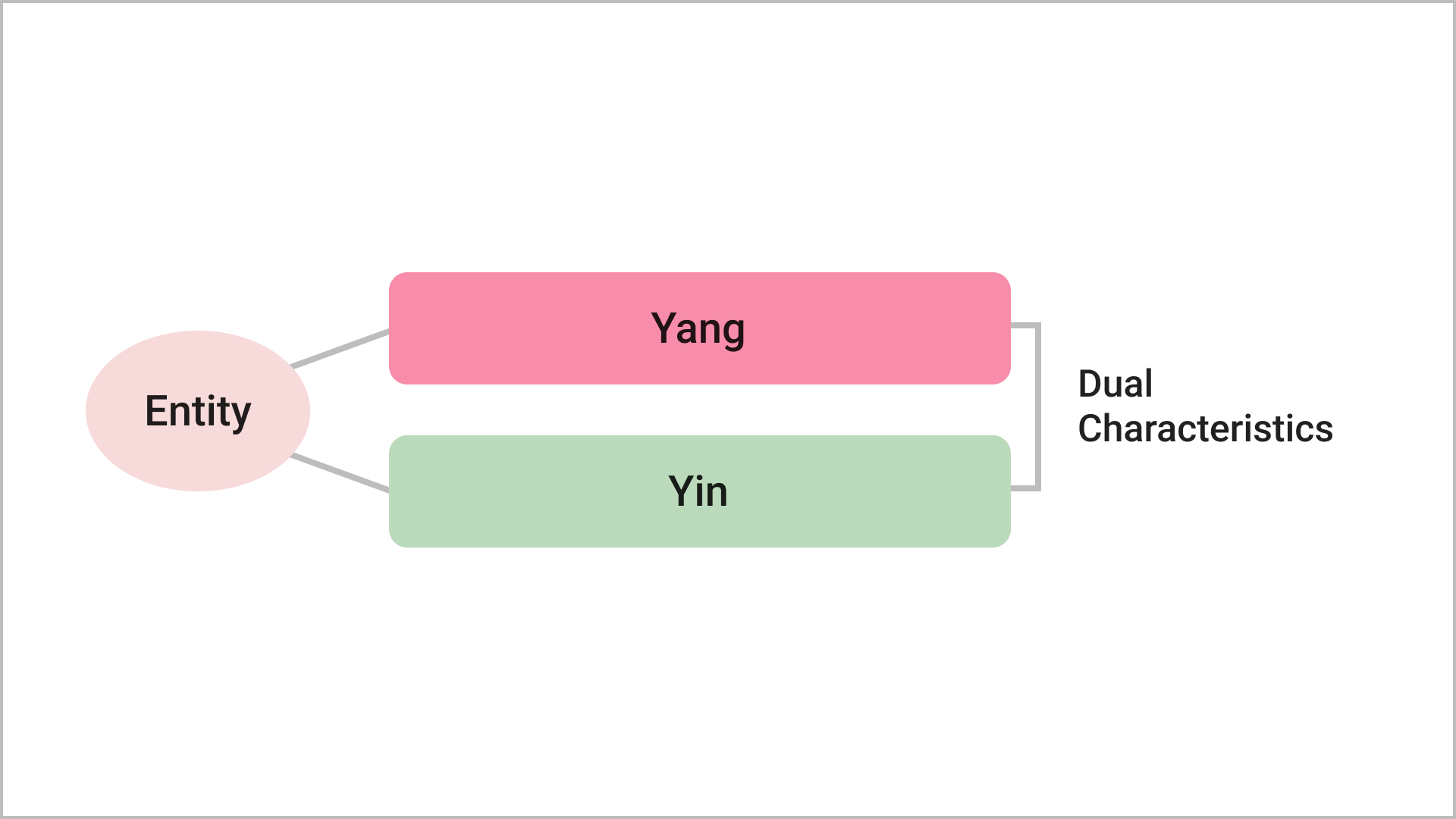
이에 대한 실례를 들어 보면, 모든 물질의 궁극적인 구성요소인 소립자(素粒子)들은 모두 양성 음성 또는 양성과 음성의 중화에 의한 중성(中性) 등을 띠고 있는데, 이것들이 이성성상의 상대적 관계를 맺음으로 써 원자(原子)를 형성한다. 그리고 이러한 원자들도 양성 또는 음성을 띠게 되는데, 이것들의 이성성상이 상대적 관계를 맺음으로써 물질의 분자(分子)를 형성하는 것이다. 이와 같이 형성된 물질들이 또한 서로 이성성상의 상대적 관계에 의하여 식물 또는 동물에 흡수됨으로써 그것들의 영양이 되는 것이다.
For example, subatomic particles, the basic building blocks of all matter, possess either a positive charge, a negative charge or a neutral charge formed by the neutralization of positive and negative constituents. When particles join with each other through the reciprocal relationships of their dual characteristics, they form an atom. Atoms, in turn, display either a positive or a negative valence. When the dual characteristics within one atom enter into reciprocal relationships with those in another atom, they form a molecule. Molecules formed in this manner engage in further reciprocal relationships between their dual characteristics to eventually become nourishment fit for consumption by plants and animals.
그리고 모든 식물은 각각 수술과 암술에 의하여 존속하고, 또 모든 동물은 각각 수컷과 암컷에 의하여 번식 생존한다. 인간을 보더라도 하나님이 남성인 아담을 창조하시고는 독처(獨處)하는 것이 좋지 못하다고 하시면서(창 2 : 18) 그의 대상으로 여성인 해와를 창조하신 후에야 선하다고 하셨다(창 1 : 31).
Plants propagate by means of stamen and pistil. Animals multiply and maintain their species through the relationship between males and females. According to the Bible, after God created Adam, He saw that it was not good for the man to live alone. (Gen. 2:18) Only after God created Eve as Adam’s female counterpart did He declare that His creations were “very good.” (Gen. 1.31)
그리고 전리(電離)된 양이온이나 음이온도 또한 각각 양자(陽子)와 전자(電子)의 결합으로 형성되어 있는 것과 같이, 수술이나 암술 또는 수컷이나 암컷들도 역시 각각 그 자체 내에서 양성(陽性)과 음성(陰性)의 이성성상(二性性相)이 상대적 관계를 맺음으로써 비로소 존재하는 것이다. 따라서 인간에 있어서도 남성에는 여성성상(女性性相)이, 여성에는 남성성상(男性性相)이 각각 잠재해 있는 것이다. 그뿐 아니라 삼라만상의 존재 양상이 표리(表裏), 내외(內外), 전후(前後), 좌우(左右), 상하(上下), 고저(高低), 강약(强弱), 억양(抑揚), 장단(長短), 광협(廣狹), 동서(東西), 남북(南北) 등과 같이 모두 상대적으로 되어 있는 것도 모든 피조물이 이성성상의 상대적 관계에 의하여 서로 존재하도록 창조되어 있기 때문이다.
Even though atoms become positive or negative ions after ionization, each still consists of a positive nucleus and negative electrons in stable unity. Similarly, each animal, whether male or female, maintains its life through the reciprocal relationships of yang and yin elements within itself. The same holds true for every plant. In people, a feminine nature is found latent in men and a masculine nature is found latent in women. Moreover, every creation exists with correlative aspects: inside and outside, internal and external, front and rear, right and left, up and down, high and low, strong and weak, rising and falling, long and short, wide and narrow, east and west, north and south, etc. The reason for this is that everything is created to exist through the reciprocal relationships of dual characteristics.
우리는 위에서 모든 존재가 양성과 음성의 이성성상으로 인한 상대적 관계에 의하여 존재하고 있다는 사실을 밝혔다. 나아가 우리는 모든 존재를 형성하고 있는, 보다 근본 된 또 하나의 이성성상의 상대적인 관계 를 알아야 하겠다.
Thus, we can understand that everything requires for its existence a reciprocal relationship between the dual characteristics of yang and yin.However, there is another pair of dual characteristics in reciprocal relationship which are even more fundamental to existence than the dual characteristics of yang and yin.
존재하는 것은 무엇이든지 그 외형(外形)과 내성(內性)을 갖추고 있다. 그리고 그 보이는 외형은 보이지 않는 그 내성을 닮아 난 것이다. 따라서 그 내성이 눈에 보이지는 않으나 반드시 그 어떠한 꼴을 가지고 있기 때문에 그것을 닮아 난 그 외형이 눈에 보이는 그 어떠한 꼴로써 나타나는 것이다. 이에 전자를 성상(性相)이라 하고 후자를 형상(形狀)이라고 한다. 그런데 성상과 형상은 동일한 존재의 상대적인 양면의 꼴을 말하는 것이어서, 형상은 제2의 성상이라고도 할 수 있는 것이기 때문에 이것을 통틀어서 이성성상이라고 한다.
Every entity possesses both an outer form and an inner quality. The visible outer form resembles the invisible inner quality. The inner quality, though invisible, possesses a certain structure which is manifested visibly in the particular outer form. The inner quality is called internal nature, and the outer form or shape is called external form. Since internal nature and external form refer to corresponding inner and outer aspects of the same entity, the external form may also be understood as a second internal nature. Therefore, the internal nature and external form together constitute dual characteristics.

이에 대한 예로서 인간을 들어 보기로 하자. 인간은 몸이란 외형과 마음이란 내성으로 되어 있다. 그리고 나타나 보이는 몸은 보이지 않는 그 마음을 닮아 난 것이다. 따라서 마음이 어떠한 꼴을 가지고 있기 때문에 그 마음을 닮아 난 몸도 어떠한 꼴을 가지게 되는 것이다. 관상(觀相)이나 수상(手相) 등 외모로써 보이지 않는 그의 마음과 운명을 판단할 수 있는 근거는 여기에 있다. 이에 마음을 성상(性相)이라 하고 몸을 형상(形狀)이라고 한다. 여기에서 마음과 몸은 동일한 인간의 상대적인 양면의 꼴을 말하는 것이어서, 몸은 제2의 마음이라고도 할 수 있는 것이기 때문에, 이것들을 통틀어서 이성성상(二性性相)이라고 한다. 이로써 우리는 모든 존재가 성상과 형상에 의한 이성성상의 상대적 관계에 의하여 존재하고 있다는 사실을 알게 되었다.
Let us take human beings as an example. A human being is composed of an outer form, the body, and an inner quality, the mind. The body is a visible reflection of the invisible mind. Because the mind possesses a certain structure, the body which reflects it also takes on a particular appearance. This is the idea behind a person’s character and destiny being perceived through examining his outward appearance by such methods as physiognomy or palm reading. Here, mind is the internal nature and body is the external form. Mind and body are two correlative aspects of a human being; hence, the body may be understood as a second mind. Together, they constitute the dual characteristics of a human being. Similarly, all beings exist through the reciprocal relationships between their dual characteristics of internal nature and external form.
그러면 성상과 형상은 서로 어떠한 관계를 가지고 있는 것인가? 무형(無形)의 내적인 성상이 원인이 되어 그것이 주체적인 입장에 있기 때문에, 그의 형상은 유형(有形)의 외적인 결과가 되어 그의 대상의 입장에 서게 되는 것이다. 따라서 이 양자는 서로 내적인 것과 외적인 것, 원인적인 것과 결과적인 것, 주체적인 것과 대상적인 것, 종적인 것과 횡적인 것의 상대적인 관계를 가지게 되는 것이다.
What is the relationship between internal nature and external form? The internal nature is intangible and causal, and stands in the position of a subject partner to the external form; the external form is tangible, resultant, and stands in the position of an object partner to the internal nature. The mutual relationships between these two aspects of an entity include: internal and external, cause and result, subject partner and object partner, vertical and horizontal.
이에 대한 예로서 다시 인간을 들어 보자. 마음과 몸은 각각 성상과 형상에 해당하는 것으로서, 몸은 마음을 닮았을 뿐만 아니라 마음이 명령하는 대로 동(動)하고 정(靜)하기 때문에, 인간은 그 목적을 지향하여 생(生)을 유지한다. 따라서 마음과 몸은 내(內) 외(外), 원인(原因)과 결과(結果), 주체(主體)와 대상(對象), 종(縱)과 횡(橫) 등의 상대적인 관계를 가지고 있는 것이다.
Let us again use the example of a human being, whose mind and body are his internal nature and external form, respectively. The body resembles the mind and moves according to its commands in such a way as to sustain life and pursue the mind’s purposes. Mind and body thus have a mutual relationship of internal and external, cause and result, subject partner and object partner, vertical and horizontal.
이와 같이 어떠한 피조물(被造物)에도 그 차원은 서로 다르나, 무형의 성상 즉 인간에 있어서의 마음과 같은 무형의 내적인 성상이 있어서 그것이 원인 또는 주체가 되어 인간에 있어서의 몸과 같은 그의 형상적인 부분을 움직여서, 그 개성체(個性體)로 하여금 어떠한 목적을 가진 피조물로서 존재하게 하는 것이다.
Similarly, all created beings, regardless of their level of complexity, possess an intangible internal nature, which corresponds to the human mind, and a tangible external form, which corresponds to the human body. Within each being, the internal nature, which is causal and subject, commands the external form. This relationship allows the individual being to exist and function purposefully as a creation of God.
그러므로 동물에게도 인간의 마음과 같은 것이 있어서 이것이 어떠한 목적을 지향하는 주체적인 원인이 되어 있기 때문에, 그 육체는 그 개체의 목적을 위한 생(生)을 영위하게 된다. 식물에도 역시 그러한 성상적인 부분이 있어서, 그것이 인간에 있어서의 마음과 같은 작용을 하기 때문에 그 개체는 유기적인 기능을 유지하게 되어 있다.
Animals live and move because their bodies are directed by an internal faculty corresponding to the human mind, which endows them with a certain purpose. Plants maintain their organic functions by virtue of their internal nature, which also operates like the human mind in some respects.
그뿐 아니라 인간이 서로 결합하게 되는 것은 그들 속에 각기 마음이 있기 때문인 것과 같이, 양이온과 음이온이 결합하여서 어떠한 물질을 형성하는 것도 이 두 이온들 속에 각각 그 분자(分子) 형성의 목적을 지향하는 어떠한 성상적인 부분이 있기 때문이다. 그리고 양자(陽子)를 중심하고 전자(電子)가 회전하여 원자(原子)를 형성하는 것도 역시 그것들 속에 각각 그 원자 형성의 목적을 지향하는 성상적인 부분이 있기 때문이다.
The human mind imparts to every person a natural inclination to join with others in harmony. Likewise, positive ions and negative ions come together to form particular molecules, because within every one of them exists a rudimentary internal nature that guides them toward that end.
한편 오늘의 과학에 의하면, 원자를 구성하고 있는 소립자(素粒子)는 모두 에너지로 되어 있다고 한다. 그렇다면 그 에너지가 소립자를 형성하기 위하여는 반드시 그 에너지에도 그로 하여금 소립자 형성의 목적을 지향하게 하는 성상적인 부분이 없어서는 안 된다. 한 걸음 더 나아가 우리는 이와 같이 성상(性相)과 형상(形狀)을 갖추고 있는 그 에너지를 존재케 함으로써 모든 존재계의 궁극적인 원인이 되는 한 존재를 추구하지 않을 수 없게 되는 것이다. 이 존재는 바로 모든 존재의 제1 원인으로서, 그 모든 것들의 주체적인 성상과 형상을 갖추고 있지 않으면 안 된다. 존재계의 이러한 제1 원인을 우리는 하나님이라고 부르며, 그 주체적인 성상과 형상을 하나님의 본성상(本性相)과 본형상(本形狀)이라고 한다.
Electrons assemble around nuclei to form atoms because they possess an attribute of internal nature which directs them toward that purpose. According to modern science, all particles that constitute atoms are made up of energy. For energy to form particles, it, too, must possess an internal nature which directs it to assume specific forms. Probing deeper still, we search for the Ultimate Cause which brought this energy, with its elements of internal nature and external form, into existence. This being would be the First Cause of all the myriad things in the universe. As the First Cause, it must also possess the dual characteristics of internal nature and external form, which stand in the position of subject partner to the internal natures and external forms of all beings. We call this First Cause of the universe God, and we call God’s internal nature and external form the original internal nature and original external form.
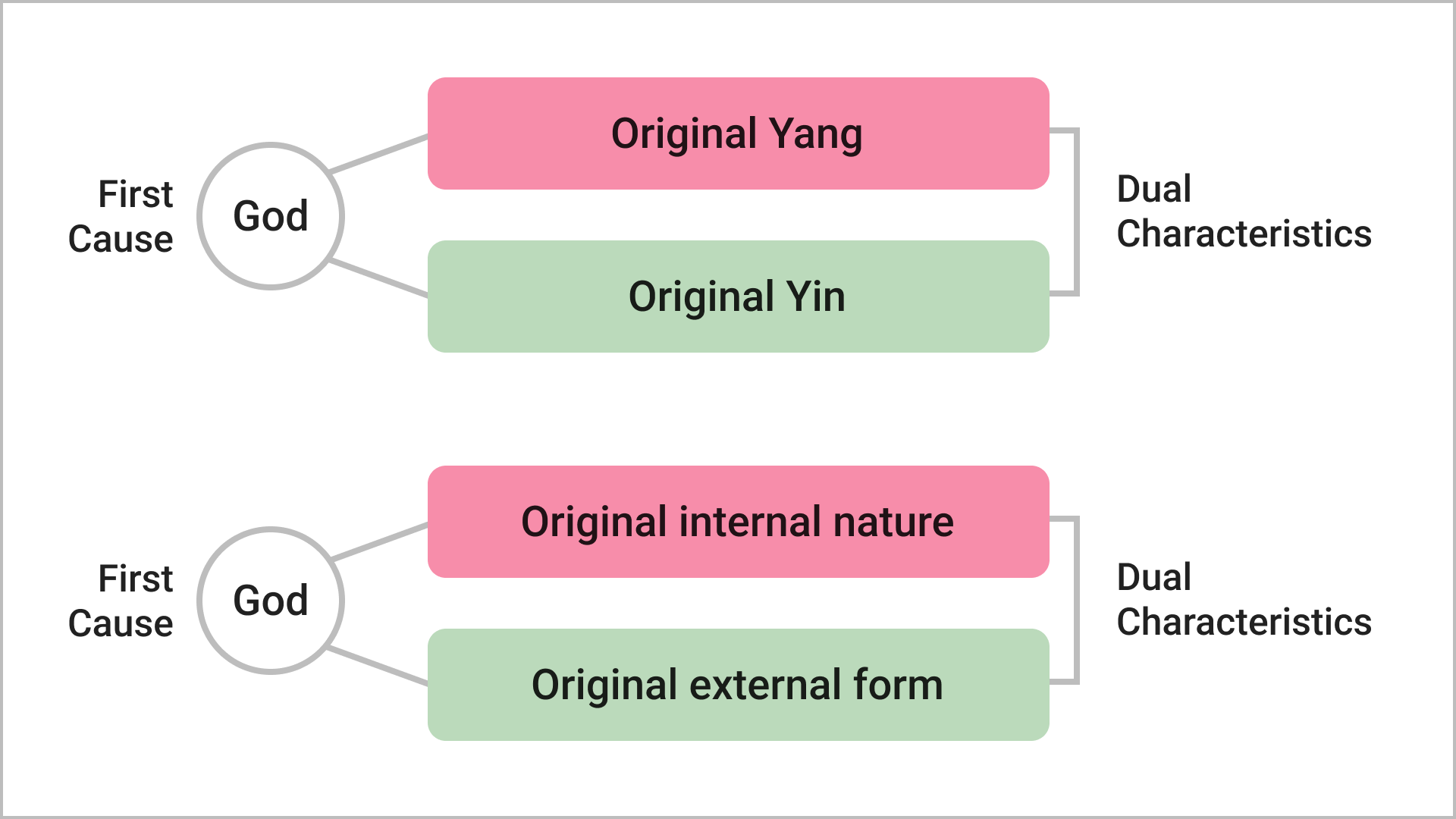
우리는 이제 바울이 논증한 바와 같이, 모든 피조물들에게 공통적으로 간직되어 있는 사실들을 추궁(追窮)함으로써 마침내 하나님은 본성상(本性相)과 본형상(本形狀)의 이성성상의 중화적 주체(中和的 主體)로서 모든 존재계의 제1 원인으로 계시다는 것을 알게 되었다.
As St. Paul indicated, by investigating characteristics that are universally present in the diverse things of creation, we can come to know the nature of God: God is the First Cause of the entire universe and its subject partner, having the harmonious dual characteristics of original internal nature and original external form.
우리는 이미 위에서, 존재하는 것은 무엇이든지 양성(陽性)과 음성(陰性)의 이성성상(二性性相)의 상대적 관계에 의하여 존재한다는 사실을 밝혔다. 그러므로 삼라만상의 제1 원인 되신 존재인 하나님도 역시 양성과 음성의 이성성상의 상대적 관계에 의하여 존재해야 된다는 것은 당연한 결론이 아닐 수 없는 것이다. 창세기 1장 27절에 하나님이 자기 형상 곧 하나님의 형상대로 사람을 창조하시되 남자와 여자를 창조하시고라고 기록되어 있는 말씀으 로 보아서도 하나님은 양성과 음성의 이성성상의 중화적 주체로도 계시다는 것을 바로 알 수 있는 것이다.
We have already mentioned that entities require for their existence the reciprocal relationship between the dual characteristics of yang and yin. It is only natural to surmise that God, the First Cause of all things, also exists based on the reciprocal relationship between His dual characteristics of yang and yin. The verse “So God created man in his own image, in the image of God he created him; male and female he created them” (Gen. 1:27) supports the idea that God, as the subject partner, has dual characteristics of yang and yin in perfect harmony.
그러면 성상(性相)과 형상(形狀)의 이성성상과 양성(陽性)과 음성(陰性)의 이성성상은 서로 어떠한 관계를 가지고 있는가?
What is the relationship between the dual characteristics of internal nature and external form and the dual characteristics of yang and yin?
본래 하나님의 본성상과 본형상은 각각 본양성과 본음성의 상대적 관계를 가지고 있기 때문에, 하나님의 본양성과 본음성은 각각 본성상과 본형상의 속성(屬性)인 것이다. 그러므로 양성과 음성은 각각 성상과 형상과의 관계와 동일한 관계를 가지고 있다. 따라서 양성과 음성은 내 외, 원인과 결과, 주체와 대상, 또는 종과 횡 등의 상대적 관계를 가지고 있는 것이다. 하나님이 남성인 아담의 갈빗대를 취하여 그의 대상으로서 여성인 해와를 창조하셨다고 기록되어 있는 이유는 바로 여기에 있는 것이다(창 2 : 22). 우리는 여기에서 하나님에 있어서의 양성과 음성은 각각 남성과 여성이라고 칭한다.
God’s original internal nature and original external form each contain the mutual relationship of original yang and original yin. Therefore, original yang and original yin are attributes of original internal nature and original external form. The relationship between yang and yin is similar to that which exists between internal nature and external form. Yang and yin thus have the following mutual relationships: internal and external, cause and result, subject partner and object partner, vertical and horizontal. For this reason, it is written in Genesis that God took a rib from the man, Adam, and created a woman, Eve, to be his helper. (Gen. 2.22) In this case, the yang and yin of God were manifested in masculinity and femininity.
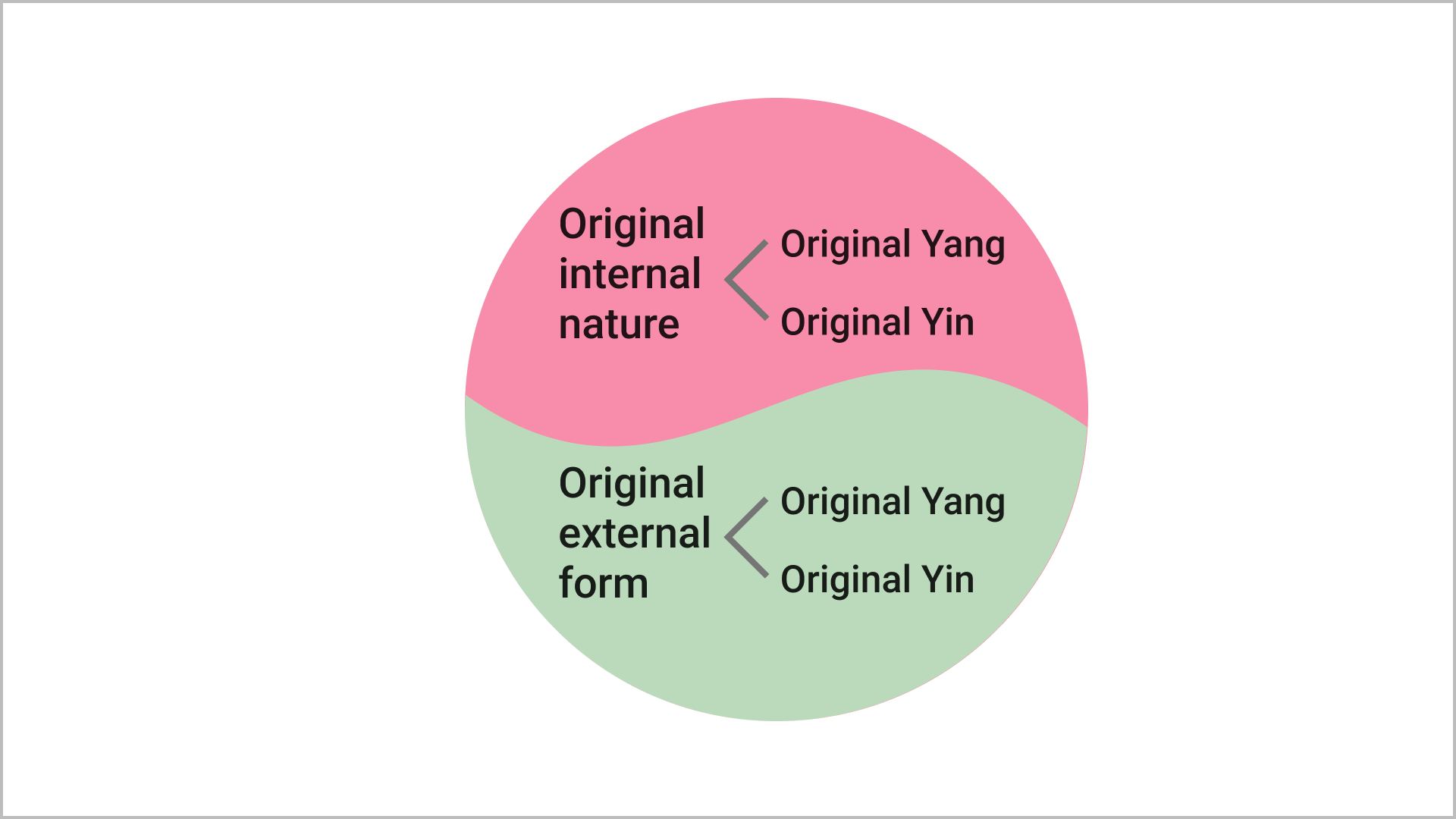
하나님을 중심하고 완성된 피조세계(被造世界)는 마치 마음을 중심하고 완성한 인간 하나와 같아서, 하나님의 창조목적(創造目的)대로만 동하고 정하는 하나의 완전한 유기체(有機體)인 것이다. 따라서 이 유기체도 성상과 형상을 갖추어야 할 것이니 그의 성상적인 존재가 하나님이시요, 그 형상적인 존재가 피조세계인 것이다. 하나님이 피조세계의 중심인 인간을 하나님의 형상이라고(창 1 : 27) 하신 이유는 바로 여기에 있다. 따라서 피조세계가 창조되기 전에 있어서의 하나님은 성상적인 남성격 주체로만 계셨기 때문에, 형상적인 여성격 대상으로 피조세계를 창조하셔야만 했던 것이다. 고린도전서 11장 7절에 남자는 하나님의 형상과 영광이니라고 기록되어 있는 성구는 바로 이러한 원리를 입증하고 있는 것이다. 이와 같이 하나님은 성상적인 남성격 주체(男性格 主體)이시기 때문에 우리는 그를 아버지라 불러 그 격위(格位)를 표시하는 것이다.
A human being attains perfection when he centers his life on his mind; likewise, the creation becomes complete only when God stands as its center. Hence, the universe is a perfect organic body that moves only according to God’s purpose of creation. As one organic body, the universe should exist in a relationship of internal nature and external form, with God as the internal nature and the created universe as the external form. For this reason it is written in the Bible that human beings, who are the center of the universe, are created in the image of God. (Gen. 1.27) Because God exists as the subject partner having the qualities of internal nature and masculinity, He created the universe as His object partner with the qualities of external form and femininity. All of this is supported by the Bible verse which states, “man . . . is the image and glory of God.” (I Cor. 11.7) In recognition of God’s position as the internal and masculine subject partner, we call Him “Our Father.”
상술(上述)한 내용을 요약하여 볼 때, 하나님은 본성상(本性相)과 본형상(本形狀)의 이성성상의 중화적 주체(中和的 主體)인 동시에, 본성상적 남성(男性)과 본형상적 여성(女性)의 이성성상의 중화적 주체로 계시며, 피조세계에 대하여는 성상적인 남성격 주체로 계시다는 사실을 알 수 있다.
In summary, God is the Subject in whom the dual characteristics of original internal nature and original external form are in harmony. At the same time, God is the harmonious union of masculinity and femininity, which manifest the qualities of original internal nature and original external form, respectively. In relation to the universe, God is the subject partner having the qualities of internal nature and masculinity.
1.2 The Relationship between God and the Universe
위에서 논술한 바에 의하여, 피조물은 모두 무형의 주체로 계시는 하나님의 이성성상을 닮아 실체로 분립된 하나님의 실체대상이라는 것을 알았다. 이러한 실체대상을 우리는 개성진리체(個性眞理體)라고 한다. 인간은 하나님의 형상적인 실체대상이기 때문에 형상적 개성진리체라 하고, 인간 이외의 피조물들은 상징적인 실체대상이기 때문에 그것들은 상징적 개성진리체라고 한다.
We have learned that every creation is God’s substantial object partner, formed in His likeness as a discrete projection of His dual characteristics. God exists as the incorporeal subject partner to all beings. Human beings are object partners embodied at the level of image, and the rest of creation are object partners embodied at the level of symbol. These object partners are called individual embodiments of truth, in image and symbol.
개성진리체는 이와 같이 하나님의 이성성상을 닮아 실체로 분립된 것이기 때문에, 그것들은 하나님의 본성상적 남성을 닮은 양성(陽性)의 실체와 그의 본형상적 여성을 닮은 음성(陰性)의 실체로 분립된다. 그뿐 아니라 이와 같이 분립된 개성진리체는 모두 하나님의 실체대상이기도 하기 때문에, 그것들은 각기 하나님의 본성상과 본형상을 닮아서 그 자체 내에 성상과 형상의 이성성상을 갖추게 되며, 그에 따라서 양성과 음성의 이성성상을 함께 갖추기도 하는 것이다.
Individual embodiments of truth are discrete manifestations of the dual characteristics of God. Therefore, they can be distinguished broadly into two classes: those of yang qualities which resemble the original internal nature and masculinity of God, and those of yin qualities which resemble the original external form and femininity of God. Although individual embodiments of truth belong to either of these two classes, since they are all substantial object partners to God – resembling His original internal nature and original external form – they each possess within themselves both internal nature and external form, and likewise both yang and yin.
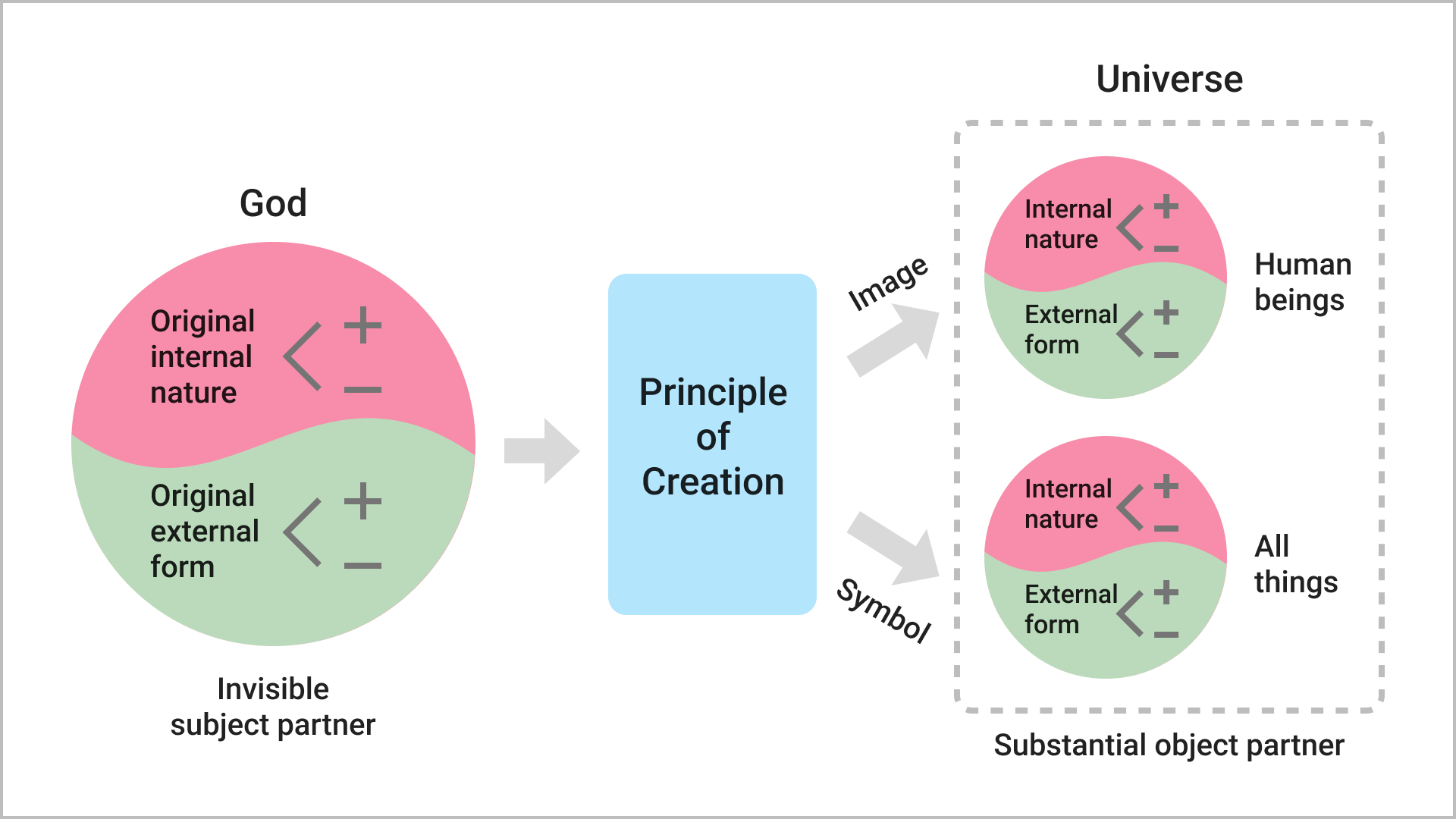
여기에서 이성성상(二性性相)을 중심하고 본 하나님과 피조세계와의 관계를 요약하면, 피조세계는 무형의 주체로 계시는 하나님의 이성성상이 창조원리에 의하여 상징적 또는 형상적인 실체로 분립된 개성진리체로써 구성되어 있는 하나님의 실체대상이다. 즉 만물은 하나님의 이성성상이 상징적인 실체로 분립된 실체대상이요, 인간은 그것이 형상적인 실체로 분립된 실체대상이다. 그리고하나님과 피조세계는 성상과 형상과의 관계와 같아서 내 외, 원인과 결과, 주체와 대상, 종과 횡 등 이성성상의 상대적인 관계를 가지고 있는 것이다.
In light of our understanding of the dual characteristics, the relationship between God and the universe can be summarized thus: The universe as a whole is a substantial object partner to God. It is composed of individual embodiments of truth, each a unique manifestation of the dual characteristics of God at either the level of image or of symbol, as governed by the Principle of Creation. The myriad qualities of God, in their duality, are apportioned into diverse human beings, each an incarnate object partner at the level of image. These qualities are also apportioned into all the diverse things of creation, each an embodied object partner at the level of symbol. The relationship between God and the universe is similar to that between internal nature and external form. It is a mutual relationship like that between dual characteristics: internal and external, cause and result, vertical and horizontal, subject partner and object partner, and so forth.
이제 우리는 창조원리(創造原理)에 입각하여 동양철학(東洋哲學)의 중심인 역학(易學)의 근본을 알아보기로 하자.
Finally, from the viewpoint of the Principle of Creation, let us investigate the metaphysical concept at the root of East Asian philosophy which is based on the Book of Changes (I Ching).
역학에서는 우주의 근본은 태극(太極, 無極)이며, 그 태극에서 음양(陰陽)이, 음양에서 금(金) 목(木) 수(水) 화(火) 토(土)의 오행(五行)이, 그리고 오행에서 만물이 생성되었다고 주장한다. 그리고 음양을 ‘도(道)’라 이르고(一陰一陽之謂道), 그 ‘도’는 곧 ‘말씀’(道也者言也)이라고 하였다. 이 내용을 종합하면 태극에서 음양 곧 말씀이 나왔고, 이 말씀에서 만물이 생성되었다는 뜻이 된다. 따라서 태극은 모든 존재의 제1 원인으로서 음양의 통일적 핵심이며 그 중화적 주체임을 의미한다.
There, the origin of the universe is the Great Ultimate (Ultimate Void). From the Great Ultimate arose yang and yin, from yang and yin came forth the Five Agents – metal, wood, water, fire and earth – and from the Five Agents all things came into existence. Yang and yin together are called the Way (Tao), or as the Book of Changes states, “One yang and one yin: this is the Way.” The Way is traditionally defined as the Word. To put all this together, from the Great Ultimate arose yang and yin, or the Word, and all things came into being based on the Word. Accordingly, the Great Ultimate is the First Cause of all existing beings, the integral nucleus and harmonious subject partner of yang and yin.
그런데 이것을 요한복음 1장 1절 내지 3절에 기록된 바 말씀은 곧 하나님이시고 이 말씀으로 만물이 창조되었다고 한 그 내용과 대조해 보면, 음양의 중화적인 주체인 그 태극(太極)은 이성성상의 중화적 주체이신 하나님을 표시한 말이라는 사실을 알 수 있다.
It is written in the Gospel of John that “the Word was with God, and the Word was God,” (John 1:1-3) and that all things were made through the Word. Comparing this to the metaphysics rooted in the Book of Changes, we can surmise that the Great Ultimate, as the harmonious source of yang and yin or the Word, is none other than God who, as we have seen, is the harmonious subject partner of dual characteristics.
창조원리(創造原理)로 보더라도 ‘말씀’이 이성성상으로 되어 있기 때문에 그 말씀으로 창조된 피조물도 이성성상으로 되어 있는 것이다. 따라서 음양이 곧 ‘말씀’이라고 한 역학(易學)의 주장은 타당한 것이다. 그러나 역학은 다만 음양을 중심하고 존재계를 관찰함으로써 그것들이 모두 성상과 형상을 갖추고 있다는 사실을 몰랐었기 때문에, 태극이 음양의 중화적 주체인 것만을 밝혔을 뿐 그것이 본래 본성상(本性相)과 본형상(本形狀)에 의한 이성성상의 중화적 주체라는 것을 밝히지 못하였다. 따라서 그 태극이 인격적인 신(神)이라는 사실에 관해서는 알지 못하였던 것이다.
According to the Principle of Creation, the fact that everything created through the Word has dual characteristics shows that the Word itself consists of dual characteristics. Consequently, the claim made in the Book of Changes that yang and yin together are the Word is valid. However, this East Asian metaphysics observes the universe exclusively from the viewpoint of yang and yin while failing to recognize that all things also possess internal nature and external form. Therefore, although it reveals that the Great Ultimate is the subject partner of harmonious yang and yin, it fails to show that the Great Ultimate is also the subject partner of harmonious original internal nature and original external form. Hence, it does not comprehend that the Great Ultimate is a God with personality.
이제 우리는 여기에서 역학에 의한 동양철학의 근본도 결국 창조원리에 의하여서만 해명된다는 사실을 알게 되었다. 그리고 근래에 한의학이 점차 그 권위를 더해 가게 되는 것도, 그것이 음양을 중심으로 한 창조원리적 근거에 입각하고 있기 때문임을 알 수 있는 것이다.
We have learned that the root concept of East Asian philosophy as based on the Book of Changes can be fully elucidated only with the help of the Principle of Creation. In recent years, Oriental medicine has become recognized to an increasing degree throughout the world. Its success is due to the fact that its founding principles, which focus upon the concepts of yang and yin, are in accordance with the Principle of Creation.